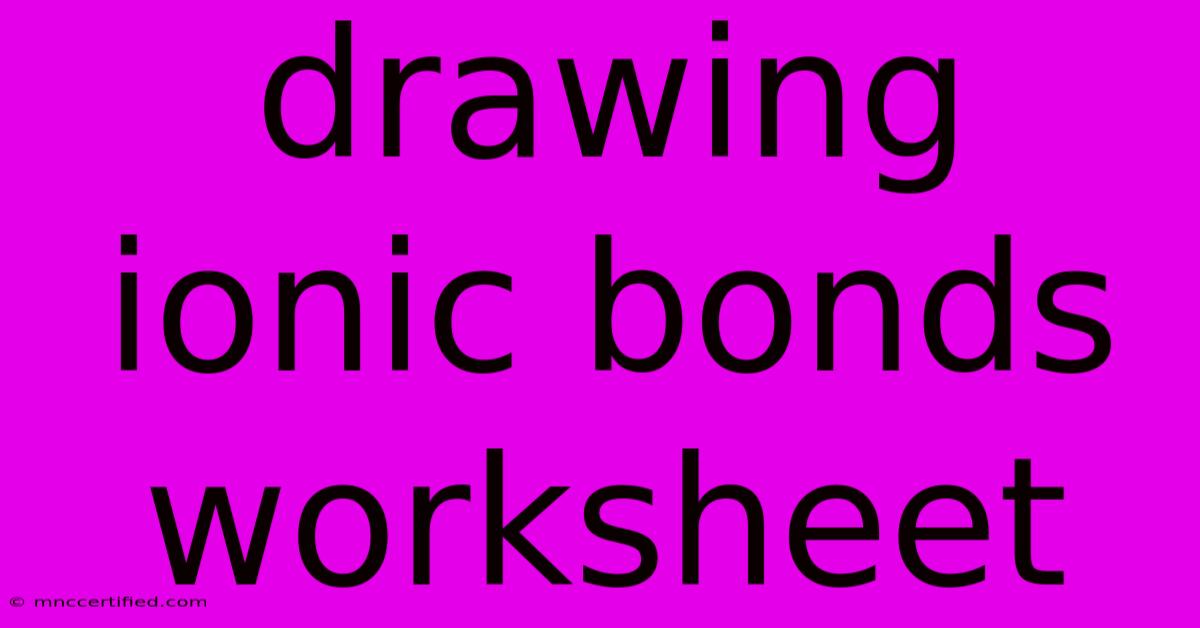Drawing Ionic Bonds Worksheet

Table of Contents
Drawing Ionic Bonds: A Comprehensive Worksheet Guide
Understanding ionic bonds is crucial for grasping fundamental chemistry concepts. This article provides a comprehensive guide to drawing ionic bonds, complete with a sample worksheet and helpful tips to ace your assignments. We'll cover everything from identifying ions to accurately representing the electrostatic attraction between them.
What are Ionic Bonds?
Ionic bonds form through the electrostatic attraction between oppositely charged ions. This happens when one atom donates an electron (or more) to another atom, creating a cation (positively charged ion) and an anion (negatively charged ion). The strong attraction between these ions results in the formation of an ionic compound.
Key Concepts to Master:
- Electronegativity: The ability of an atom to attract electrons in a chemical bond. A large difference in electronegativity between two atoms is a key indicator of ionic bonding.
- Valence electrons: The electrons in the outermost shell of an atom, which are involved in chemical bonding.
- Octet rule: Atoms tend to gain, lose, or share electrons to achieve a full outer shell of eight electrons (except for hydrogen and helium, which aim for two).
Drawing Ionic Bonds: A Step-by-Step Approach
Let's break down the process of drawing ionic bonds with a simple example: the formation of sodium chloride (NaCl), common table salt.
-
Identify the elements: We have sodium (Na) and chlorine (Cl).
-
Determine the electron configuration: Sodium has one valence electron, while chlorine has seven.
-
Predict ion formation: Sodium readily loses its one valence electron to achieve a stable octet, forming a Na⁺ ion. Chlorine gains this electron to complete its octet, forming a Cl⁻ ion.
-
Draw the ions: Represent the ions using their chemical symbols and charges. For example: Na⁺ and Cl⁻. Include the electron configuration if instructed.
-
Show the electrostatic attraction: Indicate the attraction between the positively charged sodium ion and the negatively charged chloride ion using a line or dots representing the ionic bond.
-
Write the formula: The formula for sodium chloride is NaCl, reflecting the 1:1 ratio of sodium and chloride ions.
Sample Worksheet: Drawing Ionic Bonds
(Note: This is a simplified example. A full worksheet would include more complex examples and varying levels of difficulty.)
Instructions: Draw the ionic bond formation for each pair of elements, showing the electron transfer and resulting ions. Write the chemical formula for the resulting ionic compound.
| Element Pair | Ionic Bond Drawing | Chemical Formula |
|---|---|---|
| Magnesium (Mg) & Oxygen (O) | [Space for drawing] | |
| Potassium (K) & Fluorine (F) | [Space for drawing] | |
| Calcium (Ca) & Chlorine (Cl) | [Space for drawing] |
Answer Key (Simplified): (A complete answer key would include detailed drawings of electron transfer and resulting ion configurations.)
| Element Pair | Ionic Bond Drawing | Chemical Formula |
|---|---|---|
| Magnesium (Mg) & Oxygen (O) | (Drawing showing Mg losing 2 electrons, O gaining 2) | MgO |
| Potassium (K) & Fluorine (F) | (Drawing showing K losing 1 electron, F gaining 1) | KF |
| Calcium (Ca) & Chlorine (Cl) | (Drawing showing Ca losing 2 electrons, 2 Cl gaining 1 each) | CaCl₂ |
Tips for Success
- Practice regularly: The more you practice drawing ionic bonds, the better you'll become at it.
- Use resources: Refer to textbooks, online tutorials, and interactive simulations to reinforce your understanding.
- Understand the periodic table: Familiarize yourself with the periodic table to easily determine the number of valence electrons for each element.
- Check your work: Always double-check your drawings and formulas to ensure accuracy.
Beyond the Worksheet: Advanced Concepts
Once you master the basics, you can move on to more advanced topics such as:
- Polyatomic ions: Ions composed of more than one atom.
- Ionic crystal structures: The arrangement of ions in a solid ionic compound.
- Properties of ionic compounds: High melting points, conductivity in solution, etc.
By following this guide and practicing diligently, you'll build a solid understanding of ionic bonding and excel in your chemistry studies. Remember to utilize online resources and seek assistance from your teacher or tutor if you encounter difficulties. Good luck!

Thank you for visiting our website wich cover about Drawing Ionic Bonds Worksheet. We hope the information provided has been useful to you. Feel free to contact us if you have any questions or need further assistance. See you next time and dont miss to bookmark.
Featured Posts
-
Conall Storm London Flooding
Nov 28, 2024
-
Vanderpump Rules How Stars React To Growth
Nov 28, 2024
-
Letter From Putnam Investments
Nov 28, 2024
-
Commodity Trading South Africa
Nov 28, 2024
-
Black Friday Wsl Aston Villa Deal
Nov 28, 2024